From the washing drum to the song book
Freiburg, Feb 18, 2019
If there had been a loosely worded job description for the task, it might have turned out like this: “Seeking persistent students who enjoy travelling, digging and discovering.” Persistence was certainly required for the project at the Institute for Cultural Anthropology, which examined the evolution of work culture. Under the direction of Dr. Matthias Möller, students spent a year and a half researching the subject and visiting various collections. The exhibition “Work is work is work ... collected, preserved and re-examined” will display the results until March 17, 2019. Alexander Ochs asked some of the project participants about their favorite object.
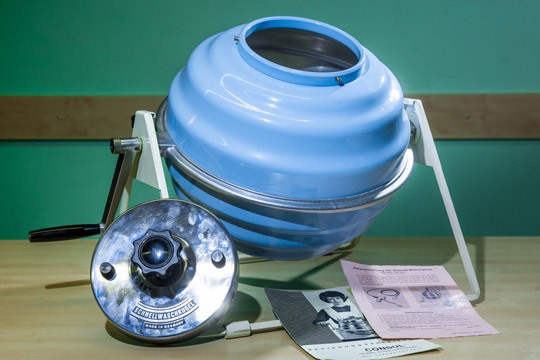 Blue time capsule: Among other things, the exhibition shows a hand washing drum, which served as a replacement for washing machines in the 1950s. Photos: Klaus Polkowski
Blue time capsule: Among other things, the exhibition shows a hand washing drum, which served as a replacement for washing machines in the 1950s. Photos: Klaus Polkowski
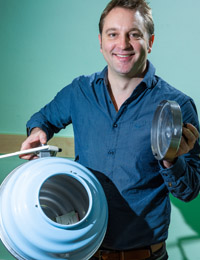
Matthias Möller: “The hand washing drum. Originally, a Tübingen teaching research project had acquired such a drum for an exhibition in 1999 on the so-called Millennium Bug, a contemporary computer problem. At that time, there was a real hype about these washing drums in view of the apocalyptic scenarios for which people wanted to be prepared. It comes from a time when there were hardly any electric washing machines - and when housework was not yet recognized as work. I find it exciting that the symbolic meaning of the same object can change greatly over time: in the 1950s as a replacement for a real washing machine, then as a travel washing machine with the camping wave of the 1960s, then in connection with countercultural dropouts and the preparation for doomsday scenarios in the 1990s.”
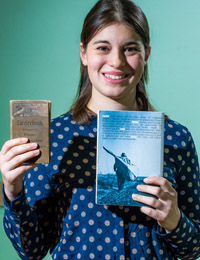
Sophia Schütz: “I chose a children's song book from 1967, which deals with songs that sing about work and that are still common today. But some of the lyrics have changed over time. The older text versions are quite something: Compared to today they are much stricter in punishing misconduct, for instance, which illustrates an interesting shift in thinking.”

Katharina Löw: “One of my favorite pieces is an audio file. It contains an interview from the 50s, which was conducted in the context of a dialect collection. A farmer talks about his work in the field, also with farm animals. That’s when the tractor came up. But for this, the man says, first of all more animals had to be bought in order to sell their milk and thus to have money for the purchase of the vehicle. However, the tractor did not simply replace the animal, but it is an exchange and interaction between the two. Besides there are four pictures from the collection of the photographer Alwin Tölle, which I like very much and which show the work with animals and machinery.”
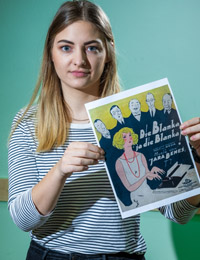
Catharina Rische: “I chose a cover illustration of a pop song from the 1920s. The illustration shows a woman with a typewriter, perhaps a typist or secretary, behind her five men in a suit with an offensive look. Next to it reads: “Blanka, oh yes Blanka.” The song lyrics say: “lush in the front, slim in the back.” The woman is wearing a fashionable short haircut and a lot of jewellery and is showing a lot of skin for her time. The song also deals with sexual transgressions in the workplace. At that time it wasn’t a big deal; it was treated in Schlager music, but today with the #MeToo debate people have become much more sensitive. I’m interested in the affective and sexualized aspect of work.”
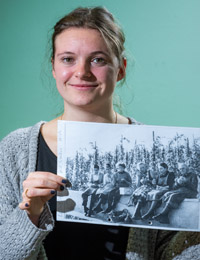
Nadja Harm: “I’ve chosen a photograph that shows women harvesting grapes. But in the picture they are not harvesting grapes. Rather, they are sitting on a wall, gossiping and dangling their feet. They are eating grapes and snacking on bread during their lunch break. The question for me is: What does interrupting work tell us about working itself? Who takes a break, how and when, especially in agricultural work? The photography only shows women and thus also conveys a certain gender aspect, namely the ‘gendered’ form of a lunch break. There are more photographs of men in the exhibit. But here you can see that women were full-fledged vineyard workers.”

Femke de Kort: “I've analyzed the NS-Frauenwarte (Nazi Women’s Observatory), a National Socialist women’s magazine. I looked at how it propagated female work. I had already dealt with right-wing extremism and populism before, but in a contemporary way. This time I approached the subject historically. When we first visited the branch of the Badisches Landesmuseum in Staufen, the cover spoke to me directly. I found it interesting to explore images, linguistic characteristics and ideologies that tragically still exist to this day.”
Viewing the exhibit
The exhibition “Work is work is work ... collected, preserved and re-examined” can be seen until March 17, 2019 at the gallery in the Andreas Dilger Winery, Urachstraße 3, 79102 Freiburg. The opening hours are Wednesdays and Thursdays from 4-7pm, Fridays from 4-9pm as well as Saturdays and Sundays from 12-5pm. On February 24th as well as on March 10th and 17th,the team will offer a guided tour at 3pm. Admission is free.
For more information

